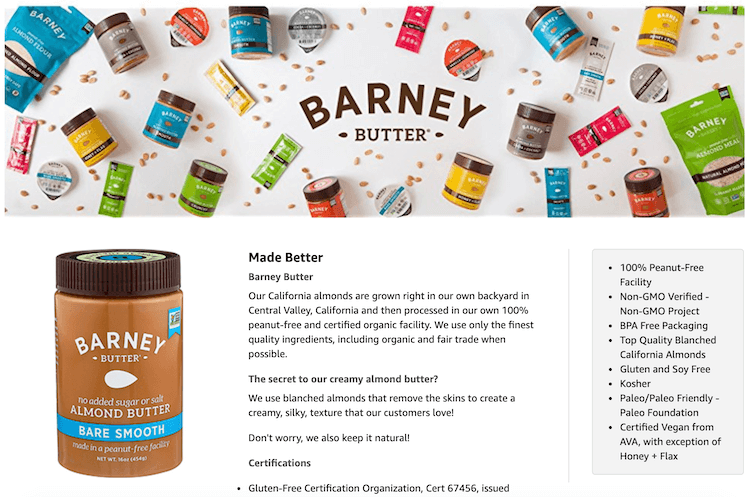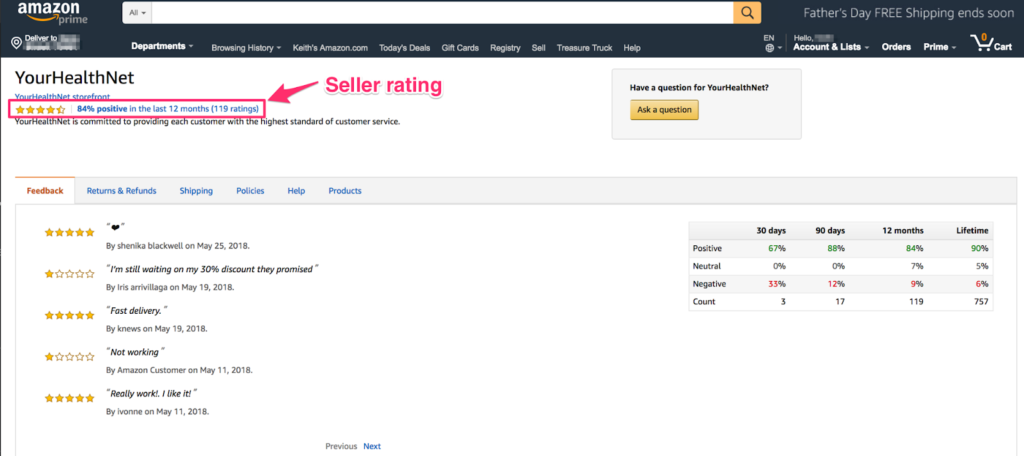Your success on Amazon doesn’t just depend on acquiring new customers: it also depends on keeping them happy. According to statistics for Rosetta, satisfied customers buy 50% more and spend 200% more.
So how do you create loyal customers that always come back to your store for more? Simple: you need to improve the customer experience. It’s the key to making your brand stand out from the crowd, driving more sales, and meeting customers’ shopping expectations.
What is Customer Experience (CX)?
Customer Experience (CX) consists of all the touchpoints and feelings your target customer goes through when interacting with your Amazon products.
It includes all the buyer journey steps, from the moment they learn about your brand to the time when they make it past checkout. The customer experience is vital to your eCommerce success, as it forces brands to put the customer first.
Let’s check out some numbers: according to a study by Oracle, 86% of customers are ready to pay more money for a better experience. The research also found that 89% of customers ditched a business for another because of poor customer experience.
So, in other words, if you’re not trying ways to improve customer experience on Amazon, you’re shooting yourself in the foot.
What Makes a Good Customer Experience
So what does a good ecommerce customer experience look like in action? Here are the components that go into building a customer experience that engages shoppers and drives sales:
Personalization
Personalization consists of adapting the shopping experience based on the individual needs of the customer. By adjusting the customer’s experience based on their interests, stage in the buyer journey, or previous purchase behavior, you can always target them with the right message at the right time.
Also, personalization helps make customers feel like you’re reaching out to them as a person, not just a prospect. Personalization goes a long way when it comes to creating a connection with your target audience.
Easy and Frictionless Navigation
There can’t be any friction or bottlenecks during the buyer’s purchase to have a quality customer experience. Any small obstacle in the shopping process can cause the customer to drop their cart and not follow through with the final purchase.
For example, let’s say that a customer is about to buy one of your products and arrives at the checkout page. However, as they’re ready to drop in their credit card information, they need to go through multiple pages before they can complete their purchase. It’s extra friction that can make them second-guess their buying decision or give up on the process.
I know you’re thinking something so simple couldn’t cause such a problem, but digitally native consumers will see a lack of professionalism if a company provides a convoluted journey, hurting both sales and brand reputation.
Another aspect of the customer experience that could create friction is if your product page isn’t mobile-friendly: 65% of eCommerce traffic now comes from mobile. So if your web page on smartphones looks clunky and is slow to load, customers won’t bother proceeding to check out. They may not even make it to adding to cart.
Memorability
An excellent ecommerce customer experience needs to leave a solid impression on your customer. By making an impact through a unique shopping experience customers will increase their brand loyalty and leave hungry for more.
For example, part of creating a unique customer experience may be promoting your ecommerce brand across different channels where each channel gets its own strategy.
How to Understand Your Customer’s Current Experience
It’s not always clear whether online shoppers are happy with your current customer experience. Thankfully, there are various tactics you can use to determine the quality of your ecommerce customer experience:
Customer Surveys
To collect your feedback on your customer experience, you can run surveys to your shoppers and ask them questions. You can ask them questions about your product, your service, their expectations, and areas where you can improve. To incentivize your customers you could even offer a small discount, coupon, or entrance into a raffle for filling out the survey.
Customer Satisfaction Score (CSAT)
As the name suggests, the customer satisfaction score (CSAT) measures the shopper’s overall satisfaction. You rate this metric based on a percentage score of 100 and can ask your customers to provide their feedback either through email or SMS.
Net Promoter Score (NPS)
Your Net Promoter Score (NPS) is a rating from 1 to 10 that measures the likelihood of a customer spreading the word about your product to others. It’s an excellent metric to measure the overall perception of your brand from customers. A good time to ask customers to send you their NPS score is right after their purchase.
Product Listing Reviews
Potentially the simplest, and easiest, way to start determining the quality of your customer experience is to take a look at the reviews of your Amazon product listings. What is the overall feedback of your brand? What frequent complaints from customers are often popping up? Do they mention customer service, how the package arrives, or unmet expectations? Reviews can give you a clear insight into what areas of the customer experience need to be improved.
6 Ways to Improve the Customer Experience on Amazon
Regardless of the current state of your customer experience, there’s always room for improvement. Optimizing the customer experience on Amazon all comes down to using the right tactics and strategy:
1. Optimize Your Product Listing

Improving the ecommerce customer experience starts by maximizing your product listing first. It’s the first thing that the customer will see when researching your brand on Amazon.
For example, the way you structure your product description is going to be incredibly important. It should include all the relevant information that customers need about your product (such as the material and size), so you can answer their questions ahead of time and reduce time in the purchase process or unhappy returns.
Also, including high-quality images in your product listing will make a significant difference. Make sure to showcase your product from all angles so the customer can get a complete overview of the product. If you have the budget for it, don’t be afraid to invest in a professional photographer to create your product pictures.
2. Identify Values to Stand For
The modern customer is more socially-aware and politically-inclined than ever. Keep in mind that you’re dealing with a generation of buyers that grew up with scandals such as the BP oil spill, which proved that companies don’t always have the best interests in mind for the world.
As a result, modern customers care a lot about aligning their values with those of the companies they support. According to a recent study done by Porter Novelli/Cone purpose, 72% of Americans believe it’s vital for companies to reflect their values.
It’s why your company must stand for values that are close to its heart. When strong values lead your ecommerce store, customers see you as more than just a product. They’ll see your brand as a force of good that helps make the world a better place and they would love to help your efforts.
For example, if you’re selling products made out of eco-friendly materials, it’s something you’ll want to mention to the customer in your item descriptions and website. It will make customers feel like they’re doing their part in making the world a better place.
3. Keep a High Amazon Seller Rating

Make sure to keep a close eye on your Amazon Seller rating. The higher the rating is, the more customers will trust your brand and be willing to do business with you. Customers will look at this rating to determine what kind of experience they’ll get with your product.
4. Collect the Most Positive Customer Reviews
Along with maintaining a high Amazon Seller rating, you want to make sure that your customer reviews are top-notch as well. Over 93% of customers will take a look at your reviews before making a purchase.
Customer reviews help shoppers gain confidence in your products and feel peace of mind in purchasing. As a result, it’s going to contribute to a better customer experience during their journey.
5. Deliver Exceptional Customer Service
Customer service is a vital aspect of ecommerce. 90% of American shoppers say that a brand’s customer service influences whether they want to do business with them.
For a better ecommerce customer experience, make sure to deliver excellent customer service. That’s going to include responding quickly to requests, actively listening to your customers needs, and keeping your word when it comes to solving their issues. This can also include the occasional extra mile in making policy exceptions or providing complimentary additional benefits in extreme circumstances.
Exceptional customer service is proof to your shoppers that you care. It will improve customer loyalty and retention by supporting shoppers more efficiently in their buyer’s journey.
6. Manage Your Inventory Effectively
As you’re selling your products on Amazon’s marketplace, you must be very careful to avoid stockouts from ever happening. It can have a significant negative impact on the quality of your customer experience.
Imagine you find a product you really like, but just as you’re about to purchase the item, you find out that it’s not available. You’ll find yourself dissatisfied and frustrated and can leave a bad taste in your mouth for the company. This bad taste can stick, and may cause customers to always opt to do business with your competitors.
That’s why you need to properly manage your inventory and reorder popular items once they’re about to run out of stock. Pattern’s Predict software helps make sure you have the resources you need to track and meet product demand.
Start Delivering the Customer Experience that Shoppers Want Today
Finding ways to improve customer experience needs to be part of every ecommerce strategy. It’s one of the best ways to create brand advocacy and encourage customers to purchase more.
However, outside of customer experience, don’t forget other aspects of ecommerce that are important, such as handling warehousing and supply chain management. By combining everything, you’ll create a winning strategy that will take your Amazon store to the next level.



